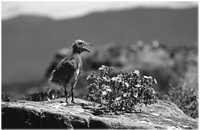Coordinators:
Alvaro Jaramillo
John Cant
Mars Muusse
Index ORG
ring projects
PDF's
1cy July
1cy Aug
1cy Sept
1cy Oct
1cy Nov
1cy Dec
2cy Jan
2cy Feb
2cy March
2cy April
2cy May
2cy June
2cy July
2cy Aug
2cy Sept
2cy Oct
2cy Nov
2cy Dec
3cy Jan
3cy Feb
3cy March
3cy April
3cy May
3cy June
3cy July
3cy Aug
3cy Sept
3cy Oct
3cy Nov
3cy Dec
4cy / sub-ad Jan
4cy / sub-ad Feb
4cy / sub-ad March
4cy / sub-ad April
4cy / sub-ad May
4cy / sub-ad June
4cy / sub-ad July
4cy / sub-ad Aug
4cy / sub-ad Sept
4cy / sub-ad Oct
4cy / sub-ad Nov
4cy / sub-ad Dec
adult Jan
adult Feb
adult March
adult April
adult May
adult June
adult July
adult Aug
adult Sept
adult Oct
adult Nov
adult Dec |
sub-adult / 4CY: May
NEW LONGEVITY RECORD OF A GLAUCOUS-WINGED GULL FROM BRITISH
COLUMBIA
R. Wayne Campbell
 Determining the maximum age attained by a wild bird requires an individual to be marked as a nestling, usually with a leg band, and subsequently recovered at the time of its death. When banded, it must be released to live a normal, wild, life in which it will encounter predators, adverse weather, starvation, and accidents (Welty 1975). Of the tens of millions of birds that have been banded in North America it is an extremely rare event to have a band return for a species over 30 years old. Determining the maximum age attained by a wild bird requires an individual to be marked as a nestling, usually with a leg band, and subsequently recovered at the time of its death. When banded, it must be released to live a normal, wild, life in which it will encounter predators, adverse weather, starvation, and accidents (Welty 1975). Of the tens of millions of birds that have been banded in North America it is an extremely rare event to have a band return for a species over 30 years old.
On 21 July 1969, a Glaucous-winged Gull (Larus glaucescens) chick (Figure 1) was banded (#0807-31818) on Mitlenatch Island, British Columbia, under a master banding permit issued to the author. Mitlenatch Island is located near the northern end of the Strait of Georgia (49º 57’ 00” N, 125º 00’ 00” W) about 13 km east of Miracle Beach on Vancouver Island. It is a major seabird colony supporting breeding Glaucous-winged Gulls, Pelagic Cormorants (Phalacrocorax pelagicus), Double-crested Cormorants (P. auritus), Pigeon Guillemots
(Cepphus culumba), and Black Oystercatchers(Haematopus bachmani) (Campbell et al. 1990a, 1990b).
On 20 September 2006, D. Dean found the banded gull dead among beach rocks about 100 m north of the northern boundary of Kitty Coleman Park. This 10 ha marine Park is located about six kilometers northwest of Courtenay on Vancouver Island, BC and only 46 km from the gull’s natal colony. The chick was about 14 days old when banded so the calculated maximum age, including leap year days, is 37 years, 2 months, 11 days old.
Verbeek (1993) suggests that the Glaucous-winged Gull rarely lives beyond 15 years and at maturity Vermeer (1963) gives the species an average life expectancy of 9.5 years. Previous longevity records for the Glaucous-winged Gull in North America are 20 years 62 days (Campbell1968), 21 years (Vermeer 1963), 24 years 9 months (Klimkiewicz 2007), 25 years 6 months (Campbell1975), 29+ years (Wakefield 1987), and 32 years (Brown 1985).
According to longevity records of North American birds reported by Clapp et al. (1982,
1983), Klimkiewicz and Futcher (1987, 1989), and Klimkiewicz et al. (1983), the Glaucous-winged Gull from British Columbia is now the fourth longest surviving species. The top three are Laysan Albatross (Phoebastria immutabilis) at 50 years and eight months, Black-footed Albatross (P. nigripes) at 40 years and eight months, and Great Frigatebird (Fregata minor) at 38 years and 2 months old.
The other species in the top ten that have been recorded in British Columbia were Arctic Tern
(Sterna paradisaea) at 34 years old and Red-tailed Tropicbird (Phaethon rubricauda) at 32 years and eight months old.
References: see PDF. |
Glaucous-winged Gull glaucescens |
 Glaucous-winged Gull glaucescens
Glaucous-winged Gull glaucescens